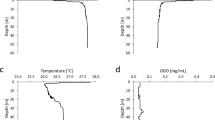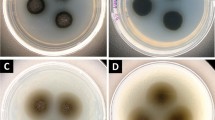Abstract
A Gram-negative, aerobic, non-spore-forming, motile and ovoid or rod-shaped bacterial strain, designated MA2-16T, was isolated from ark shell (Scapharca broughtonii) collected from the South Sea, South Korea. Strain MA2-16T was found to grow optimally at 30°C, at pH 7.0–8.0 and in the presence of 2.0% (w/v) NaCl. Neighbour-joining, maximum-likelihood and maximum-parsimony phylogenetic trees based on 16S rRNA gene sequences revealed that strain MA2-16T clustered with the type strain of Sedimentitalea nanhaiensis. The novel strain exhibited a 16S rRNA gene sequence similarity value of 97.1% to the type strain of S. nanhaiensis. In the neighbour-joining phylogenetic tree based on gyrB sequences, strain MA2-16T formed an evolutionary lineage independent of those of other taxa. Strain MA2-16T contained Q-10 as the predominant ubiquinone and C18:1 ω7c and 11-methyl C18:1 ω7c as the major fatty acids. The major polar lipids of strain MA2-16T were phosphatidylcholine, phosphatidylglycerol, phosphatidylethanolamine, an unidentified aminolipid and an unidentified lipid. The DNA G+C content of strain MA2-16T was 57.7 mol% and its DNA-DNA relatedness values with the type strains of S. nanhaiensis and some phylogenetically related species of the genera Leisingera and Phaeobacter were 13–24%. On the basis of the data presented, strain MA2-16T is considered to represent a novel genus and novel species within the family Rhodobacteraceae, for which the name Aliisedimentitalea scapharcae gen. nov., sp. nov. is proposed. The type strain is MA2-16T (=KCTC 42119T =CECT 8598T).
Similar content being viewed by others
References
Barrow, G.I. and Feltham, R.K.A. 1993. Cowan and Steel’s Manual for the Identification of Medical Bacteria, 3rd edn. Cambridge: Cambridge University Press.
Baumann, P. and Baumann, L. 1981. The marine Gram-negative eubacteria: genera Photobacterium, Beneckea, Alteromonas, Pseudomonas, and Alcaligenes, pp. 1302–1331. In Starr, M.P., Stolp, H., Trüper, H.G., Balows, A., and Schlegel, H.G. (eds.), The Prokaryotes. Springer-Verlag, Berlin, Germany.
Breider, S., Scheuner, C., Schumann, P., Fiebig, A., Petersen, J., Pradella, S., Klenk, H.P., Brinkhoff, T., and Göker, M. 2014. Genome-scale data suggest reclassifications in the Leisingera-Phaeobacter cluster including proposals for Sedimentitalea gen. nov. and Pseudophaeobacter gen. nov. Front Microbiol. 5, 416.
Bruns, A., Rohde, M., and Berthe-Corti, L. 2001. Muricauda ruestringensis gen. nov., sp. nov., a facultatively anaerobic, appendaged bacterium from German North Sea intertidal sediment. Int. J. Syst. Evol. Microbiol. 51, 1997–2006.
Cohen-Bazire, G., Sistrom, W.R., and Stanier, R.Y. 1957. Kinetic studies of pigment synthesis by nonsulfur purple bacteria. J. Cell Comp. Physiol. 49, 25–68.
Embley, T.M. and Wait, R. 1994. Structural lipids of eubacteria, pp. 121–161. In Goodfellow, M. and O’Donnell, A.G. (eds.), Modern Microbial Methods. Chemical Methods in Prokaryotic Systematics. John Wiley & Sons, Chichester, England.
Ezaki, T., Hashimoto, Y., and Yabuuchi, E. 1989. Fluorometric deoxyribonucleic acid-deoxyribonucleic acid hybridization in microdilution wells as an alternative to membrane filter hybridization in which radioisotopes are used to determine genetic relatedness among bacterial strains. Int. J. Syst. Bacteriol. 39, 224–229.
Gaboyer, F., Tindall, B.J., Ciobanu, M.C., Duthoit, F., Romancer, M.L., and Alain, K. 2013. Phaeobacter leonis sp. nov., a novel alphaproteobacterium from Mediterranean Sea sediments. Int. J. Syst. Evol. Microbiol. 63, 3301–3306.
Hameed, A., Shahina, M., Lim, S.Y., Nakayan, P., Liu, Y.C., Lai, W.A., and Hsu, Y.H. 2014. Youngimonas vesicularis gen. nov., sp. nov., of the family Rhodobacteraceae, isolated from surface seawater, reclassification of Donghicola xiamenensis Tan et al. 2009 as Pseudodonghicola xiamenensis gen. nov., comb. nov. and emended description of the genus Donghicola Yoon et al. 2007. Int. J. Syst. Evol. Microbiol. 64, 2729–2737.
Komagata, K. and Suzuki, K.I. 1987. Lipid and cell wall analysis in bacterial systematics. Methods Microbiol. 19, 161–207.
Lanyi, B. 1987. Classical and rapid identification methods for medically important bacteria. Methods Microbiol. 19, 1–67.
Liu, C., Zhang, X.Y., Su, H.N., Zhou, M.Y., Chen, B., Li, H., Chen, X.L., Zhao, D.L., Zhou, B.C., Shi, M., et al. 2014. Puniceibacterium antarcticum gen. nov., sp. nov., isolated from seawater. Int. J. Syst. Evol. Microbiol.} 64}, 1566–15
Martens, T., Heidorn, T., Pukall, R., Simon, M., Tindall, B.J., and Brinkhoff, T. 2006. Reclassification of Roseobacter gallaeciensis Ruiz-Ponte et al. 1998 as Phaeobacter gallaeciensis gen. nov., comb. nov., description of Phaeobacter inhibens sp. nov., reclassification of Ruegeria algicola (Lafay et al. 1995) Uchino et al. 1999 as Marinovum algicola gen. nov., comb. nov., and emended descriptions of the genera Roseobacter, Ruegeria and Leisingera. Int. J. Syst. Evol. Microbiol. 56, 1293–1304.
Minnikin, D.E., O’Donnell, A.G., Goodfellow, M., Alderson, G., Athalye, M., Schaal, A., and Parlett, J.H. 1984. An integrated procedure for the extraction of bacterial isoprenoid quinones and polar lipids. J. Microbiol. Methods 2, 233–241.
Oren, A. and Garrity, G.M. 2014. List of new names and new combinations previously effectively, but not validly, published, Validation List no. 160. Int. J. Syst. Evol. Microbiol. 64, 3603–3606.
Park, S., Park, D.S., Bae, K.S., and Yoon, J.H. 2014. Phaeobacter aquaemixtae sp. nov., isolated from the junction between the ocean and a freshwater spring. Int. J. Syst. Evol. Microbiol. 64, 1378–1383.
Ruiz-Ponte, C., Cilia, V., Lambert, C., and Nicolas, J.L. 1998. Roseobacter gallaeciensis sp. nov., a new marine bacterium isolated from rearings and collectors of the scallop Pecten maximus. Int. J. Syst. Bacteriol. 48, 537–542.
Sasser, M. 1990. Identification of bacteria by gas chromatography of cellular fatty acids. MIDI Inc., Newark, DE, USA.
Schaefer, J.K., Goodwin, K.D., McDonald, I.R., Murrell, J.C., and Oremland, R.S. 2002. Leisingera methylohalidivorans gen. nov., sp. nov., a marine methylotroph that grows on methyl bromide. Int. J. Syst. Evol. Microbiol. 52, 851–859.
Stackebrandt, E. and Goebel, B.M. 1994. Taxonomic note: a place for DNA-DNA reassociation and 16S rRNA sequence analysis in the present species definition in bacteriology. Int. J. Syst. Bacteriol. 44, 846–849.
Staley, J.T. 1968. Prosthecomicrobium and Ancalomicrobium: new prosthecate freshwater bacteria. J. Bacteriol. 95, 1921–1942.
Sun, F., Wang, B., Liu, X., Lai, Q., Du, Y., Li, G., Luo, J., and Shao, Z. 2010. Leisingera nanhaiensis sp. nov., isolated from marine sediment. Int. J. Syst. Evol. Microbiol. 60, 275–280.
Tamaoka, J. and Komagata, K. 1984. Determination of DNA base composition by reverse-phase high-performance liquid chromatography. FEMS Microbiol. Lett. 25, 125–128.
Vandecandelaere, I., Segaert, E., Mollica, A., Faimali, M., and Vandamme, P. 2008. Leisingera aquimarina sp. nov., isolated from a marine electroactive biofilm, and emended descriptions of Leisingera methylohalidivorans Schaefer et al. 2002, Phaeobacter daeponensis Yoon et al. 2007 and Phaeobacter inhibens Martens et al. 2006. Int. J. Syst. Evol. Microbiol. 58, 2788–2793.
Vandecandelaere, I., Segaert, E., Mollica, A., Faimali, M., and Vandamme, P. 2009. Phaeobacter caeruleus sp. nov., a blue-coloured, colony-forming bacterium isolated from a marine electroactive biofilm. Int. J. Syst. Evol. Microbiol. 59, 1209–1214.
Wayne, L.G., Brenner, D.J., Colwell, R.R., Grimont, P.A.D., Kandler, O., Krichevsky, M.I., Moore, L.H., Moore, W.E.C., Murray, R.G.E., Stackebrandt, E., et al. 1987. International Committee on Systematic Bacteriology. Report of the ad hoc committee on reconciliation of approaches to bacterial systematics. Int. J. Syst. Bacteriol. 37, 463–464.
Yamamoto, S. and Harayama, S. 1995. PCR amplification and direct sequencing of gyrB genes with universal primers and their application to the detection and taxonomic analysis of Pseudomonas putida strains. Appl. Environ. Microbiol. 61, 1104–1109.
Yoon, J.H., Kang, S.J., Lee, S.Y., and Oh, T.K. 2007a. Phaeobacter daeponensis sp. nov., isolated from a tidal flat of the Yellow Sea in Korea. Int. J. Syst. Evol. Microbiol. 57, 856–861.
Yoon, J.H., Km, H., Kim, S.B., Kim, H.J., Kim, W.Y., Lee, S.T., Goodfellow, M., and Park, Y.H. 1996. Identification of Saccharomonospora strains by the use of genomic DNA fragments and rRNA gene probes. Int. J. Syst. Bacteriol. 46, 502–505.
Yoon, J.H., Kim, I.G., Shin, D.Y., Kang, K.H., and Park, Y.H. 2003. Microbulbifer salipaludis sp. nov., a moderate halophile isolated from a Korean salt marsh. Int. J. Syst. Evol. Microbiol. 53, 53–57.
Yoon, J.H., Lee, S.Y., Kang, S.J., Lee, C.H., and Oh, T.K. 2007b. Pseudoruegeria aquimaris gen. nov., sp. nov., isolated from seawater of the East Sea in Korea. Int. J. Syst. Evol. Microbiol. 57, 542–547.
Yoon, J.H., Lee, S.T., and Park, Y.H. 1998. Inter- and intraspecific phylogenetic analysis of the genus Nocardioides and related taxa based on 16S rRNA gene sequences. Int. J. Syst. Bacteriol. 48, 187–194.
Zhang, D.C., Li, H.R., Xin, Y.H., Liu, H.C., Chi, Z.M., Zhou, P.J., and Yu, Y. 2008. Phaeobacter arcticus sp. nov., a psychrophilic bacterium isolated from the Arctic. Int. J. Syst. Evol. Microbiol. 58, 1384–1387.
Author information
Authors and Affiliations
Corresponding author
Additional information
Supplemental material for this article may be found at http://www.springerlink.com/content/120956.
Electronic supplementary material
Rights and permissions
About this article
Cite this article
Kim, YO., Park, S., Nam, BH. et al. Aliisedimentitalea scapharcae gen. nov., sp. nov., isolated from ark shell Scapharca broughtonii . J Microbiol. 53, 495–502 (2015). https://doi.org/10.1007/s12275-015-5075-7
Received:
Revised:
Accepted:
Published:
Issue Date:
DOI: https://doi.org/10.1007/s12275-015-5075-7




